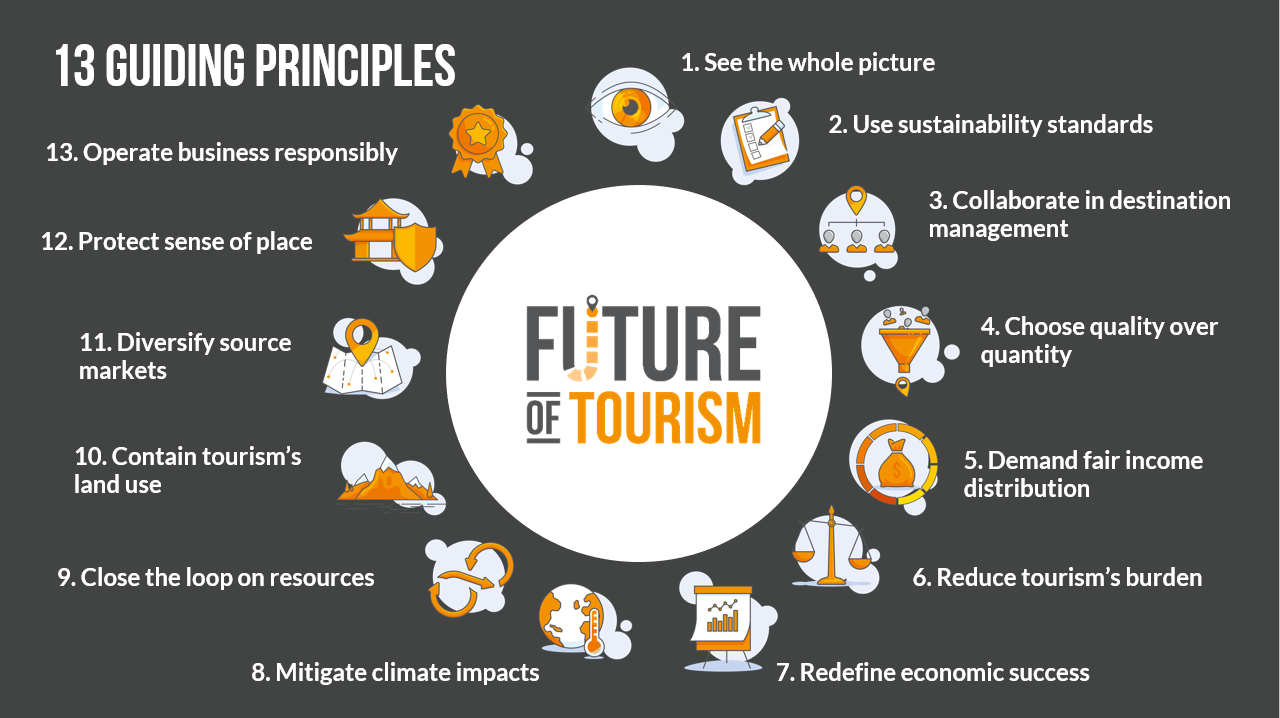Ten Steps to Kickstart Your Destination Stewardship Journey
Think back to your most meaningful travel experience–what made it so memorable?
Chances are, it was the destination’s natural beauty, enriching cultural experiences, conversations with local people, or delicious food that made that experience unforgettable.
We all understand how important these elements are to our travel experiences. But, as an industry, we aren’t focused enough on centering the health of destinations in our future planning.
How can we shift from a tourism model focused on volume and profit to one that considers the impact of tourism on local people, environments, and the transformative effects on travelers?
Introducing: destination stewardship.
Destination stewardship refers to the responsible management of a specific geographic area, usually a tourism destination, with the goal of preserving its natural, cultural, social, and economic resources for present and future generations. It’s a crucial long-term strategy for the sustainability of the travel industry.
Right now, the future of our industry is at risk. All the things that make travel and tourism fun and beautiful, such as local food, cultural experiences, wildlife, and natural beauty, could be abused, ruined, and degraded if we don’t manage our assets responsibly.
What can the tourism industry do to safeguard destinations for future generations? Check out these ten ways to kickstart your destination stewardship journey!
1.) Dream Big
We need as many leaders as possible re-orienting their companies toward destination stewardship. It’s important to have big goals and to chart a path forward to reach those goals.
Action steps:
Start with brainstorming a vision for what the best-case scenario is for the destination in question in five, 10, or even 20 years. Reframe your perceptions of what tourism is and think about what tourism could be and what it could do.
Create a vision in collaboration with local non-profits, members of diverse communities, and businesses making a positive impact. These folks are already envisioning a better future!
2.) Involve the Community
One of the most important factors in your destination stewardship success will be your engagement with the local community. Community members should be part of the visioning process, planning, and execution of your goals.
Action steps:
Establish a destination stewardship council with community members, through which you can conduct visioning sessions, surveys, and public forums.
You will also need to engage various stakeholders. Check out the following list provided by the Center for Responsible Travel (CREST) in the blog, “Building a community-centered destination stewardship initiative.”
3.) Understand the Impacts of Tourism
Destination stewardship hinges on maximizing the positive benefits of tourism in the destination and minimizing the negative ones. Understanding tourism’s impact on a destination is the necessary first step toward maximizing its potential.
Action steps:
Survey local constituents to determine tourism’s major impacts on your destination. Some of the impacts (both negative and positive) could be:
Overcrowding in particular areas or during peak seasons
Preservation of historical sites
Protection of environmental resources
Issues with traffic and parking
Increased rent or property values
Overuse of trails and other natural areas; trash, pollution
Local resident sentiment (noise, wait times, access)
Use these measurements to establish a baseline from which to improve. People and companies who sell destinations can also rely on these impact assessments (either performed in-house or provided by destinations) to think through their own responsible travel policies.
4.) Reconsider Your Metrics
Rethink success metrics beyond traditional measures like "heads in beds." By measuring other significant impacts, you can steward your destination to a greater level of success and continue to meet demand for authentic, meaningful travel.
Action steps:
Develop alternative metrics tailored to your destination's uniqueness, such as resident satisfaction, resource use, low-carbon transportation, conservation efforts, and cultural experiences.
Establish SMART goals and integrate these metrics into a comprehensive strategy, seeking community input for a well-rounded perspective.
Snæfellsnes, Iceland, for example, has worked hard over the past ten years to redefine economic success in order to protect its natural resources and cultural heritage from the negative impacts of tourism. Learn more about their destination stewardship journey in the article “Doing It Better: Snæfellsnes Peninsula, Iceland, in the Destination Stewardship Report.
5.) Protect Natural and Environmental Resources
Tourism has the potential to massively impact ecosystems. Over 80% of the value in our industry is attributed to goods and services that significantly rely on nature (Nature Positive Travel & Tourism – World Travel & Tourism Council & Animondial). Therefore, it is imperative to work to safeguard destinations’ natural resources.
Action steps:
Promote tourism products that contribute to biodiversity conservation and engage visitors in ecosystem restoration.
Encourage carbon reduction and work with local governments on waste management policies.
Implement destination animal welfare policies to ensure responsible tourism practices.
6.) Protect Cultural Resources
Protecting cultural heritage in destinations is vital for preserving the identity of communities and fostering educational and cultural exchange. It ensures the well-being of local residents, maintains a balance between visitor influx and conservation, and contributes to the long-term sustainability of destinations.
Action steps:
Support the preservation and restoration of cultural heritage sites, such as historical buildings, arts districts, street art, religious buildings, statues and other public art.
Highlight authentic cultural programs that showcase local culture and traditions, and help guests avoid cultural uses that might be appropriated or heavily commercialized.
7.) Drive Business to Diverse, Local Communities
One of the most important steps on your destination stewardship journey is to drive business to diverse, local communities that do not typically benefit from travel and tourism. Promoting community-based tourism empowers residents, helps prevent overtourism, and keeps money circulating within the community.
Action steps:
Support local businesses, non-profits, social enterprises, and B Corps to enhance fair employment opportunities and promote diversity, equity, and inclusion.
Identify vetted, impactful local businesses via the Tourism Cares Meaningful Travel Map, which highlights sustainable, community-led enterprises, products, services, accommodations and tours around the globe.
8.) Train and/or Certify Your Local Businesses and Partners
While you are on your stewardship journey, you will come across a lot of suppliers (local businesses, hotel, attractions, restaurants, shops, etc.) and community partners who could use some training. Broaden your destination stewardship initiatives by offering training and certification to your suppliers or partners.
Action steps:
Support social enterprises and non-profits in crafting tourism products that align with their missions.
Conduct training sessions for smaller ventures to enhance their participation in the travel trade.
Consider implementing a recognition or certification program.
Explore partnerships with existing certification programs such as Green Destinations or B Corp to amplify your impact.
9.) Educate Travelers
One of the primary responsibilities of a DMO (Destination Marketing Organization) or CVB (Convention & Visitors Bureau) is to communicate all of the unique aspects of a destination and try to convince people to visit and take advantage of all that there is to offer. This presents a huge opportunity to educate travelers (and trade partners) about how to travel to your destination responsibly.
Action steps:
Highlight stories of respectful cultural engagement, waste reduction, support for local businesses, and sustainable resource use.
Collaborate with local initiatives to encourage responsible travel behavior.
Share your sustainability journey transparently in marketing materials to guide travelers and attract partners with similar objectives.
10.) Get Help! 
All destinations are unique, and each one will require a distinct set of strategies to meet stewardship objectives. If you are ready to fully commit to destination stewardship, there are programs and organizations out there to help.
Action steps:
The Future of Tourism Coalition should be your first stop. There are reference materials to help you learn more about specific topics and tools and roadmaps to help you build your strategy.
If you are a destination trying to promote local suppliers/tourism partners who bring positive impacts to your local communities and environment, consider joining Tourism Cares as a member and adding your destination to the Meaningful Travel Map. The Map is a B2B tool that helps the travel trade and sustainably minded travelers easily source organizations making positive social and environmental impacts in destinations.
You can also seek certification, such as through Green Destinations, Biosphere, or others. We recommend starting with Green Destinations, as it is a GSTC-Accredited Certification Body for Destinations.
Destination stewardship is vital for the survival of the travel and tourism industry. Although it may seem overwhelming, taking one step at a time and collaborating with others can make a significant impact.
For more information and resources on getting started on your destination stewardship journey, check out Tourism Cares’ “Stewarding Destinations into a Meaningful Future.” module on its Meaningful Travel Platform.






